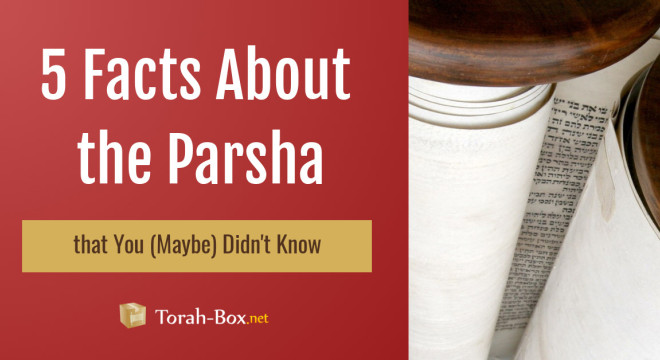
Re'eh
5 Facts About Parshat Re'eh that You (Maybe) Didn’t Know
Discover and learn every week, "5 Facts" written on the weekly Parshah that you can share at your Shabbos table.
שְׁמֹ֣רוְשָׁמַעְתָּ֗ אֵ֚תכָּל־הַדְּבָרִ֣יםהָאֵ֔לֶּהאֲשֶׁ֥ראָנֹכִ֖ימְצַוֶּ֑ךָּ לְמַעַן֩ יִיטַ֨בלְךָ֜ וּלְבָנֶ֤יךָ אַחֲרֶ֙יךָ֙ עַד־עוֹלָ֔םכִּ֤יתַעֲשֶׂה֙ הַטּ֣וֹבוְהַיָּשָׁ֔רבְּעֵינֵ֖יה' אֱ--לֹהֶֽיךָ׃ (ס) (12:28)
Be careful to heed all these commandments that I enjoin upon you; thus it will go well with you and with your descendants after you forever, for you will be doing what is good and right in the sight of the LORD your God.
1. How many times should one review his learning?
From here the Talmud learns the importance of reviewing one’s Torah studies. We are told that one who has reviewed something 101 times knows it better to one who only reviewed 100 times. The number 101 is significant because the name of the Angel Gavriel, who is in charge of Torah and memory, has a numerical value of 101. The teaches us that one who reviews 101 times is assisted by Gavriel to retain what one has learned. The numerical difference between Zachor/remember (227) and Shocheach/forget (328) is 101. This teaches us that reviewing one’s studies 101 times makes the difference between remembering and forgetting it. (Chagiga 9b, Meam Loez.)
לֹא־תַעֲשֶׂ֣הכֵ֔ןה' אֱ---לֹהֶ֑יךָ כִּי֩ כָּל־תּוֹעֲבַ֨תה' אֲשֶׁ֣רשָׂנֵ֗אעָשׂוּ֙ לֵא--לֹ֣הֵיהֶ֔םכִּ֣יגַ֤םאֶת־בְּנֵיהֶם֙ וְאֶת־בְּנֹ֣תֵיהֶ֔םיִשְׂרְפ֥וּ בָאֵ֖שׁ לֵֽא--לֹהֵיהֶֽם׃ (12:31)
You shall not act thus toward the LORD your God, for they perform for their gods every abhorrent act that the LORD detests; they even offer up their sons and daughters in fire to their gods.
2. Who else would pagans sacrifice?
- Pagans would not only sacrifice their sons and daughters to their gods but also their aged parents. (Sifri)
אַיָּ֥לוּצְבִ֖יוְיַחְמ֑וּרוְאַקּ֥וֹ וְדִישֹׁ֖ןוּתְא֥וֹ וָזָֽמֶר׃ (14:5)
The deer, the gazelle, the roebuck, the wild goat, the ibex, the antelope, and the zamer.
3. What iz a “zemer”?
- The zemer is a giraffe. (Sefer Hashorashim by the Radak)
וְכָל־בְּהֵמָ֞המַפְרֶ֣סֶתפַּרְסָ֗הוְשֹׁסַ֤עַתשֶׁ֙סַע֙ שְׁתֵּ֣יפְרָס֔וֹתמַעֲלַ֥תגֵּרָ֖הבַּבְּהֵמָ֑האֹתָ֖הּ תֹּאכֵֽלוּ׃ (14:6)
And any other animal that has true hoofs which are cleft in two and brings up the cud in the animal, you may eat.
4. What do the words “in the animal” come to teach us?
- From the words “in the animal” the Talmud learns that an embryo found in a slaughtered animal, known as a “ben Pekua” doesn’t need to be slaughtered in order to be eaten. Furthermore, the otherwise forbidden fat (chelev) of a ben pakua is permitted. Nevertheless, the sages decreed that even a ben pakua must be slaughtered if it is alive so that people don’t mistakenly think that animals may be eaten without being slaughtered. Even the amniotic sac is allowed to be eaten if the animal was slaughtered properly. (Ran, Chulin 65, 77)
אֶת־זֶה֙ תֹּֽאכְל֔וּ מִכֹּ֖לאֲשֶׁ֣רבַּמָּ֑יִםכֹּ֧לאֲשֶׁר־ל֛וֹ סְנַפִּ֥ירוְקַשְׂקֶ֖שֶׂתתֹּאכֵֽלוּ׃ (14:9)
These you may eat of all that live in water: you may eat anything that has fins and scales.
5. A special fish that knows about Shabbath?
- There is a fish called the “shivutah” that is said to come out on to dry land every week as Shabbat begins and then returns to the water after Shabbat ends. (Shut Shem MiShimon, Kidushin 41a)
Torah-Box.net Account
To access the entire Torah-Box.net website, sign up for free in less than a minute.
Weekly Parsha
 Candle Lighting - New York
Candle Lighting - New York
Friday January 2nd, 2026 at 16:22 *Shabbat ends at 17:27 *
change my location
* Times given as an indication, check the times of your community










